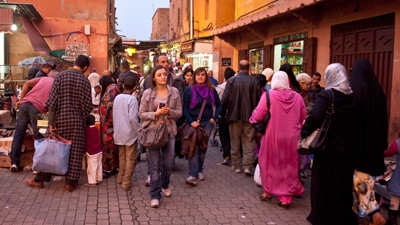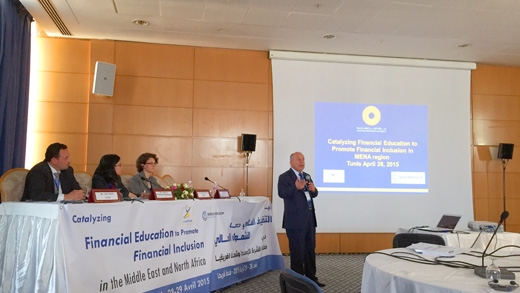Symposium on Financial Literacy and Financial Inclusion, April 28-29, 2015, Tunis, Tunisia
Creating economic opportunity and fostering financial inclusion is at the heart of challenges the countries in the Middle East and North Africa (MENA) have been negotiating amidst sweeping political and social transitions of the last few years.
The MENA countries have the lowest labor force participation in the world (46%), and the highest number of unemployed young people, close to 30%, according to ILO. The region will need to create some 46 million jobs to cut in half the unemployment rate by 2020.
Only 14% of adults in MENA have an account at a formal financial institution, the lowest out of all world regions, according to the latest 2014 Findex data. Access to financial services makes it easier for people to manage cash flow to deal with daily expenditures, absorb financial shocks and emergencies, invest in education and health, or finance income-generating activities. It also is critical for small business owners as it allows microenterprises to invest in fixed capital, expand and employ more people.
At last month’s symposium on financial education held in Tunis, Tunisia, policymakers, central bank authorities, financial service providers and civil society discussed how to increase financial literacy in the region to support financial inclusion and economic development for all, including women and youth.
The symposium was organized by the World Bank in partnership with the Center of Arab Women for Training and Research (CAWTAR) and Microfinance Opportunities.
Leveraging Technology to Deliver Financial Education
An estimated 500 million people worldwide need financial literacy training, said Dr. Guy Stuart, Executive Director of Microfinance Opportunities, in his opening remarks which provided a global overview of financial education initiativesThe financing gap facing authorities and providers to provide such training is approximately $7 billion.
The countries in MENA have only recently focused on financial education programs, which other countries, particularly Brazil and Eastern Europe, prioritized after the 2008 financial crisis.
The symposium focused on regional best practices and lessons from global trendsetters on delivering financial education, including the International Labour Organization (Tunisia), CAWTAR (Tunisia, Egypt, and Morocco), the Centre Mohammed VI(Morocco) and CEOSS (Egypt).
Technology is critical in making financial education accessible: it lowers the cost of delivering training and allows for training to be customized to the needs of low-income consumers. Many approaches combine classroom with tech-based learning, such as online modules, videos, radio spots and soap operas.
Participants shared global innovative practices. For example, a program coordinated through the Central Bank of Nigeria uses text messages to deliver financial education to girls with mobile savings accounts.
Another program, created by Juntos Finanzas, sends text messages with real-time money management advice to financial institutions’ clients. Juntos Finanzas, a for-profit social enterprise of Stanford’s Center for Social Innovation, is active in South Asia and East Africa.
Finding a National Champion
Countries need to mobilize financial literacy champions within national governments, develop relevant materials and curricula, and integrate financial literacy within national education systems.
Nezha Saadani, head of the National Foundation for Financial Literacy housed at the Central Bank of Morocco, discussed the country’s experience in prioritizing financial education.
Saadani emphasized the importance of developing a national strategy and investing in diagnostic analysis to establish empirical data to frame issues related to financial education.
For example, a 2014 nationally-representative financial capability survey in Morocco showed that women and those living in rural areas score significantly lower on financial capability metrics (budgeting, coping with unforseen events, etc.) than the general population.


